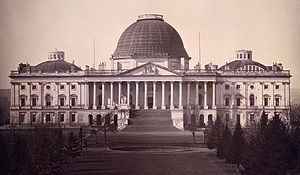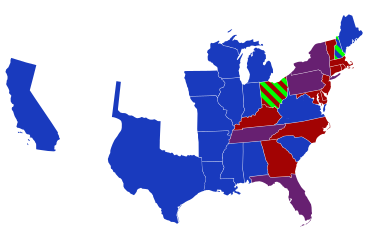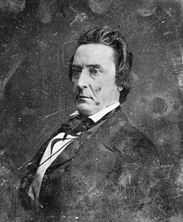31St United States Congress
The 31st United States Congress was a meeting of the legislative branch of the United States federal government, consisting of the United States Senate and the United States House of Representatives.
It met in Washington, D.C., from March 4, 1849, to March 4, 1851, during the 16 months of the Zachary Taylor presidency and the first eight months of the administration of Millard Fillmore's. The apportionment of seats in this House of Representatives was based on the 1840 United States census. The Senate had a Democratic majority, while there was a Democratic plurality in the House.
| 31st United States Congress | |
|---|---|
30th ← → 32nd | |
 United States Capitol (1846) | |
March 4, 1849 – March 4, 1851 | |
| Members | 62 senators 233 representatives 2 non-voting delegates |
| Senate majority | Democratic |
| Senate President | Millard Fillmore (W) (until July 9, 1850) Vacant (from July 9, 1850) |
| House majority | Democratic (plurality) |
| House Speaker | Howell Cobb (CU) |
| Sessions | |
| Special: March 5, 1849 – March 23, 1849 1st: December 3, 1849 – September 30, 1850 2nd: December 2, 1850 – March 4, 1851 | |
Major events
- March 4, 1849: Zachary Taylor became President of the United States
- June, 1849: Relations with France broke down as the French ambassador Guillaume-Tell de La Vallée Poussin engaged in "insulting and confrontational" behavior towards President Taylor, shortly after this a row erupted with France over reparations which France owed the United States. The president of France, Napoleon III, made this worse by making remarks that led to several members of Congress openly condemning him.
- December 3–22, 1849: The election for the House speakership takes 63 ballots.
- March 7, 1850: Senator Daniel Webster gave his "Seventh of March" speech in which he endorsed the Compromise of 1850 to prevent a possible civil war
- May 22, 1850: Senate votes 42-11 in favor of ratifying the Clayton–Bulwer Treaty after the motion to do so was put forth by William R. King of Alabama. The results of the vote were celebrated in Britain.
- July 9, 1850: President Taylor died and Vice President Millard Fillmore became President.
Major legislation
- September 9, 1850: Compromise of 1850, sess. 1, chs. 48-51, 9 Stat. 446 - 9 Stat. 458
- September 18, 1850: Fugitive Slave Act, sess. 1, ch. 60, 9 Stat. 462
- September 20, 1850: "An Act to suppress the Slave Trade in the District of Columbia," sess. 1, ch. 63, 9 Stat. 467
- September 29, 1850: Donation Land Claim Act, sess. 1, ch. 76, 9 Stat. 496
States admitted and territories organized
- September 9, 1850 — As part of the Compromise of 1850:
- Texas's borders were changed, ch. 49, 9 Stat. 446
- New Mexico Territory was organized, ch. 49, 9 Stat. 448
- California was admitted as a state, ch. 50, 9 Stat. 452
- Utah Territory was organized, ch. 51, 9 Stat. 453
Party summary
Senate
During this Congress, two Senate seats were added for the new state of California.
| Party (shading shows control) | Total | Vacant | ||||
|---|---|---|---|---|---|---|
| Democratic (D) | Free Soil (FS) | Whig (W) | Other | |||
| End of previous congress | 38 | 0 | 21 | 1 | 60 | 0 |
| Begin | 33 | 2 | 25 | 0 | 60 | 0 |
| End | 36 | 24 | 62 | |||
| Final voting share | 58.1% | 3.2% | 38.7% | 0.0% | ||
| Beginning of next congress | 34 | 2 | 21 | 0 | 57 | 5 |
House of Representatives
During this Congress, two House seats were added for the new state of California.
| Party (shading shows control) | Total | Vacant | ||||||
|---|---|---|---|---|---|---|---|---|
| Know Nothing (A) | Democratic (D) | Free Soil (FS) | Whig (W) | Independent (I) | Other | |||
| End of previous congress | 1 | 111 | 0 | 114 | 1 | 2 | 229 | 1 |
| Begin | 1 | 113 | 9 | 107 | 0 | 0 | 230 | 1 |
| End | 114 | 105 | 1 | 3 | ||||
| Final voting share | 0.4% | 49.6% | 3.9% | 45.7% | 0.4% | 0.0% | ||
| Beginning of next congress | 0 | 128 | 3 | 85 | 0 | 17 | 233 | 0 |
Leadership

Millard Fillmore
Senate
- President: Millard Fillmore (W), until July 9, 1850; vacant thereafter.
- President pro tempore: David Atchison (D), until May 5, 1850
- William R. King (D), from May 6, 1850
House of Representatives
- Speaker: Howell Cobb (D), elected December 22, 1849, after 63 ballots
- Democratic Caucus Chairman: James Thompson
Members
This list is arranged by chamber, then by state. Senators are listed by class, and representatives by district.
Senate

(until December 2, 1849)
(from May 6, 1850)
Senators were elected by the state legislatures every two years, with one-third beginning new six-year terms with each Congress. Preceding the names in the list below are Senate class numbers, which indicate the cycle of their election. In this Congress, Class 1 meant their term ended with this Congress, facing re-election in 1850; Class 2 meant their term began in the last Congress, facing re-election in 1852; and Class 3 meant their term began in this Congress, facing re-election in 1854.
House of Representatives
The names of members of the House of Representatives are preceded by their district numbers.
Changes in membership
The count below reflects changes from the beginning of the first session of this Congress.
Senate
- Replacements: 5
- Democrats (D): no net change
- Whigs (W): no net change
- Deaths: 1
- Resignations: 3
- Seats from newly admitted states: 2
- Interim appointments: 4
- Total seats with changes: 8
| State (class) | Vacated by | Reason for change | Successor | Date of successor's formal installation |
|---|---|---|---|---|
| Illinois (3) | James Shields (D) | Senate voided election March 6, 1849, as Sen. Shields was determined not to have been a US citizen for the number of years required by the Constitution. Incumbent was re-elected October 27, 1849, having by then qualified. | James Shields (D) | Seated December 3, 1849 |
| Maryland (1) | Reverdy Johnson (W) | Resigned March 7, 1849, having been appointed United States Attorney General | David Stewart (W) | Appointed December 6, 1849 |
| Alabama (2) | Benjamin Fitzpatrick (D) | Sen. Dixon Lewis successor elected November 30, 1849 | Jeremiah Clemens (D) | Elected November 30, 1849 |
| Maryland (1) | David Stewart (W) | Successor elected January 12, 1850 | Thomas Pratt (W) | Elected January 12, 1850 |
| South Carolina (2) | John C. Calhoun (D) | Died March 31, 1850 | Franklin H. Elmore (D) | Appointed April 11, 1850 |
| South Carolina (2) | Franklin H. Elmore (D) | Died May 29, 1850 | Robert W. Barnwell (D) | Appointed June 4, 1850 |
| Ohio (1) | Thomas Corwin (W) | Resigned July 20, 1850, after being appointed United States Secretary of the Treasury | Thomas Ewing (W) | Appointed July 20, 1850 |
| Massachusetts (1) | Daniel Webster (W) | Resigned July 22, 1850, after being appointed United States Secretary of State again. | Robert C. Winthrop (W) | Appointed July 30, 1850 |
| California (1) | New state | California admitted to the Union September 9, 1850. The first Senator was elected September 10, 1850. | John C. Frémont (D) | Elected September 10, 1850 |
| California (3) | New state | California admitted to the Union September 9, 1850. The first Senator was elected September 10, 1850. | William M. Gwin (D) | Elected September 10, 1850 |
| South Carolina (2) | Robert W. Barnwell (D) | Successor elected December 18, 1850 | Robert Rhett (D) | Elected December 18, 1850 |
| Massachusetts (1) | Robert C. Winthrop (W) | Successor elected February 1, 1851 | Robert Rantoul Jr. (D) | Elected February 1, 1851 |
House of Representatives
- Replacements: 11
- Democrats (D): 2 seat net gain
- Whigs (W): 2 seat net loss
- Deaths: 8
- Resignations: 5
- Contested election:1
- Seats from newly admitted states: 2
- Total seats with changes: 16
| District | Vacated by | Reason for change | Successor | Date of successor's formal installation |
|---|---|---|---|---|
| Minnesota Territory At-large | Vacant | Seat remained vacant after territory became organized at end of previous congress | Henry H. Sibley | Seated July 7, 1849 |
| Vermont 3rd | George Perkins Marsh (W) | Resigned some time in 1849 | James Meacham (W) | Seated December 3, 1849 |
| Ohio 6th | Rodolphus Dickinson (D) | Died March 20, 1849 | Amos E. Wood (D) | Seated December 3, 1849 |
| Virginia 15th | Alexander Newman (D) | Died September 8, 1849 | Thomas Haymond (W) | Seated November 8, 1849 |
| Georgia 1st | Thomas B. King (W) | Resigned March 3, 1850 | Joseph W. Jackson (D) | Seated March 4, 1850 |
| Massachusetts 2nd | Daniel P. King (W) | Died July 25, 1850 | Vacant | Not filled this term |
| Iowa 1st | William Thompson (D) | Seat declared vacant June 29, 1850, after contested election. House ruled neither candidate entitled to seat and forced special election | Daniel F. Miller (W) | Seated December 20, 1850 |
| Massachusetts 1st | Robert C. Winthrop (W) | Resigned July 30, 1850, after being appointed to the US Senate | Samuel A. Eliot (W) | Seated August 22, 1850 |
| Louisiana 2nd | Charles M. Conrad (W) | Resigned August 17, 1850, after being appointed United States Secretary of War | Henry A. Bullard (W) | Seated December 5, 1850 |
| New Hampshire 3rd | James Wilson (W) | Resigned September 9, 1850 | George W. Morrison (D) | Seated October 8, 1850 |
| California At-large | California admitted into the Union September 9, 1850, and seat remained vacant until September 11, 1850 | Edward Gilbert (D) | Seated September 11, 1850 | |
| California At-large | California admitted into the Union September 9, 1850, and seat remained vacant until September 11, 1850 | George W. Wright (I) | Seated September 11, 1850 | |
| Pennsylvania 15th | Henry Nes (W) | Died September 10, 1850 | Joel B. Danner (D) | Seated December 2, 1850 |
| Pennsylvania 11th | Chester P. Butler (W) | Died October 5, 1850 | John Brisbin (D) | Seated November 13, 1850 |
| Louisiana 3rd | John H. Harmanson (D) | Died October 24, 1850 | Alexander G. Penn (D) | Seated December 30, 1850 |
| Ohio 6th | Amos E. Wood (D) | Died November 19, 1850 | John Bell (W) | Seated January 7, 1851 |
| Texas 1st | David S. Kaufman (D) | Died January 31, 1851 | Vacant | Not filled this term |
Committees
Lists of committees and their party leaders.
Senate
| House of Representatives
|
Joint committees
- Enrolled Bills (Chairman: Sen. Thomas J. Rusk then Sen. George Badger)
- The Library (Chairman: N/A)
- The Printing (Chairman: N/A)
Caucuses
- Democratic (House)
- Democratic (Senate)
Employees
Senate
- Chaplain: Henry Slicer (Methodist), until January 9, 1850
- Clement M. Butler (Episcopalian), elected January 9, 1850
- Secretary: Asbury Dickins
- Sergeant at Arms: Robert Beale
House of Representatives
- Chaplain: Ralph Gurley (Presbyterian)
- Clerk: Thomas J. Campbell, died April 13, 1850
- Richard M. Young, elected April 17, 1850
- Doorkeeper: Robert E. Horner
- Postmaster: John M. Johnson
- Reading Clerks: [data missing]
- Sergeant at Arms: Nathan Sargent, until January 15, 1850
- Adam J. Glossbrenner, from January 15, 1850
See also
- 1848 United States elections (elections leading to this Congress)
- 1850 United States elections (elections during this Congress, leading to the next Congress)
Notes
References
- Martis, Kenneth C. (1989). The Historical Atlas of Political Parties in the United States Congress. New York: Macmillan Publishing Company.
- Martis, Kenneth C. (1982). The Historical Atlas of United States Congressional Districts. New York: Macmillan Publishing Company.
External links
- Statutes at Large, 1789-1875
- Senate Journal, First Forty-three Sessions of Congress
- House Journal, First Forty-three Sessions of Congress
- Biographical Directory of the U.S. Congress
- U.S. House of Representatives: House History
- U.S. Senate: Statistics and Lists
- Congressional Directory for the 31st Congress, 1st Session. Force's Picture of the city of Washington and its vicinity. William Q. Force. 1850.
- Congressional Directory for the 31st Congress, 1st Session (1st Revision). U.S. Govt. Print. Off., etc. 1850.
- Congressional Directory for the 31st Congress, 1st Session (2nd Revision). 1850.
This article uses material from the Wikipedia English article 31st United States Congress, which is released under the Creative Commons Attribution-ShareAlike 3.0 license ("CC BY-SA 3.0"); additional terms may apply (view authors). Content is available under CC BY-SA 4.0 unless otherwise noted. Images, videos and audio are available under their respective licenses.
®Wikipedia is a registered trademark of the Wiki Foundation, Inc. Wiki English (DUHOCTRUNGQUOC.VN) is an independent company and has no affiliation with Wiki Foundation.



